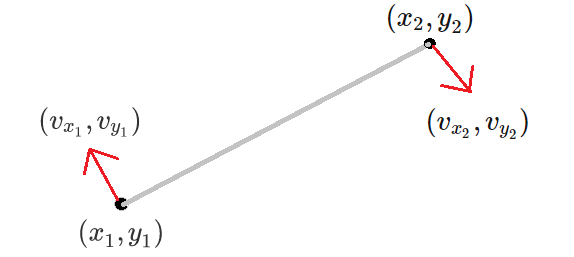Rod End Velocity (Optimization)

Consider a rigid rod in the x y plane with end points at ( x 1 , y 1 ) = ( 1 , 3 ) and ( x 2 , y 2 ) = ( 4 , 5 ) at a certain instant in time.
In that same instant, the velocities of its end points are ( v x 1 , v y 1 ) = ( − 2 , 6 ) and ( v x 2 , v y 2 ) = ( ? , ? ) .
What is the minimum possible value of ( v x 2 2 + v y 2 2 ) ?
The answer is 2.769.
This section requires Javascript.
You are seeing this because something didn't load right. We suggest you, (a) try
refreshing the page, (b) enabling javascript if it is disabled on your browser and,
finally, (c)
loading the
non-javascript version of this page
. We're sorry about the hassle.
2 solutions
A similar approach - we have ( ( 1 − 2 t ) − ( 4 + v x 2 t ) ) 2 + ( ( 3 + 6 t ) − ( 5 + v y 2 t ) ) 2 = 1 3 and thus ( 2 + v x 2 ) 2 t + 6 ( 2 + v x 2 ) + ( 6 − v y 2 ) 2 t − 4 ( 6 − v y 2 ) = 0 . Substituting t = 0 yields 6 ( 2 + v x 2 ) = 4 ( 6 − v y 2 ) , and hence v y 2 = 2 6 − 3 v x 2 . Thus d x d ( v x 2 2 + v y 2 2 ) = d x d ( v x 2 2 + ( 2 6 − 3 v x 2 ) 2 ) = 0 ⟹ v x 2 = 1 3 1 8 ⟹ min ( v x 2 2 + v y 2 2 ) = 1 3 3 6 ≈ 2 . 7 6 9 .
Since the rod is rigid, the velocities of the two endpoints must have the same component parallel to the rod. In other words 3 v x 2 + 2 v y 2 = ( 3 2 ) ⋅ ( v x 2 v y 2 ) = ( 3 2 ) ⋅ ( v x 1 v y 1 ) = 3 v x 1 + 2 v y 1 = 6 But then, using the Cauchy-Schwarz Inequality, 3 6 = ( 3 v x 2 + 2 v y 2 ) 2 ≤ ( 3 2 + 2 2 ) ( v x 2 2 + v y 2 2 ) and hence v x 2 2 + v y 2 2 ≥ 1 3 3 6 , with equality when v x 2 = 1 3 1 8 , v y 2 = 1 3 1 2 .